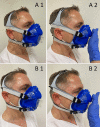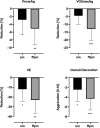Effects of surgical and FFP2/N95 face masks on cardiopulmonary exercise capacity
- PMID: 32632523
- PMCID: PMC7338098
- DOI: 10.1007/s00392-020-01704-y
Effects of surgical and FFP2/N95 face masks on cardiopulmonary exercise capacity
Abstract
Background: Due to the SARS-CoV2 pandemic, medical face masks are widely recommended for a large number of individuals and long durations. The effect of wearing a surgical and a FFP2/N95 face mask on cardiopulmonary exercise capacity has not been systematically reported.
Methods: This prospective cross-over study quantitated the effects of wearing no mask (nm), a surgical mask (sm) and a FFP2/N95 mask (ffpm) in 12 healthy males (age 38.1 ± 6.2 years, BMI 24.5 ± 2.0 kg/m2). The 36 tests were performed in randomized order. The cardiopulmonary and metabolic responses were monitored by ergo-spirometry and impedance cardiography. Ten domains of comfort/discomfort of wearing a mask were assessed by questionnaire.
Results: The pulmonary function parameters were significantly lower with mask (forced expiratory volume: 5.6 ± 1.0 vs 5.3 ± 0.8 vs 6.1 ± 1.0 l/s with sm, ffpm and nm, respectively; p = 0.001; peak expiratory flow: 8.7 ± 1.4 vs 7.5 ± 1.1 vs 9.7 ± 1.6 l/s; p < 0.001). The maximum power was 269 ± 45, 263 ± 42 and 277 ± 46 W with sm, ffpm and nm, respectively; p = 0.002; the ventilation was significantly reduced with both face masks (131 ± 28 vs 114 ± 23 vs 99 ± 19 l/m; p < 0.001). Peak blood lactate response was reduced with mask. Cardiac output was similar with and without mask. Participants reported consistent and marked discomfort wearing the masks, especially ffpm.
Conclusion: Ventilation, cardiopulmonary exercise capacity and comfort are reduced by surgical masks and highly impaired by FFP2/N95 face masks in healthy individuals. These data are important for recommendations on wearing face masks at work or during physical exercise.
Keywords: Cardiopulmonary; Exercise capacity; FFP2/N95; Surgical masks; Ventilation.
Conflict of interest statement
None.
Figures


Comment in
-
Impact of wearing a facial covering on aerobic exercise capacity in the COVID-19 era: is it more than a feeling?Clin Res Cardiol. 2020 Dec;109(12):1595-1596. doi: 10.1007/s00392-020-01725-7. Epub 2020 Aug 24. Clin Res Cardiol. 2020. PMID: 32833178 Free PMC article. No abstract available.
-
Letter to the editors referring to Fikenzer, S., Uhe, T., Lavall, D., Rudolph, U., Falz, R., Busse, M., Hepp, P., & Laufs, U. (2020). Effects of surgical and FFP2/N95 face masks on cardiopulmonary exercise capacity. Clinical Research in Cardiology.Clin Res Cardiol. 2020 Dec;109(12):1598-1599. doi: 10.1007/s00392-020-01735-5. Epub 2020 Sep 23. Clin Res Cardiol. 2020. PMID: 32965557 No abstract available.
-
Effects of surgical and FFP2/N95 face masks on cardiopulmonary exercise capacity: the numbers do not add up.Clin Res Cardiol. 2020 Dec;109(12):1605-1606. doi: 10.1007/s00392-020-01748-0. Epub 2020 Oct 9. Clin Res Cardiol. 2020. PMID: 33034744 Free PMC article. No abstract available.
References
-
- CDC (2020) Recommendation regarding the use of cloth face coverings, especially in areas of significant community-based transmission
-
- ECDC (2020) Using face masks in the community—reducing COVID-19 transmission from potentially asymptomatic or pre-symptomatic people through the use of face masks
-
- RKI Robert Koch-Institut: Mund-Nasen-Bedeckung im öffentlichen Raum als weitere Komponente zur Reduktion der Übertragungen von COVID-19. Strategie-Ergänzung zu empfohlenen Infektionsschutzmaßnahmen und Zielen (3. Update) Epid Bull. 2020;19:3–5. doi: 10.25646/673. - DOI
-
- WHO (2020) Advice on the use of masksin the context of COVID-19
Publication types
MeSH terms
Substances
LinkOut - more resources
Full Text Sources
Medical
Miscellaneous

